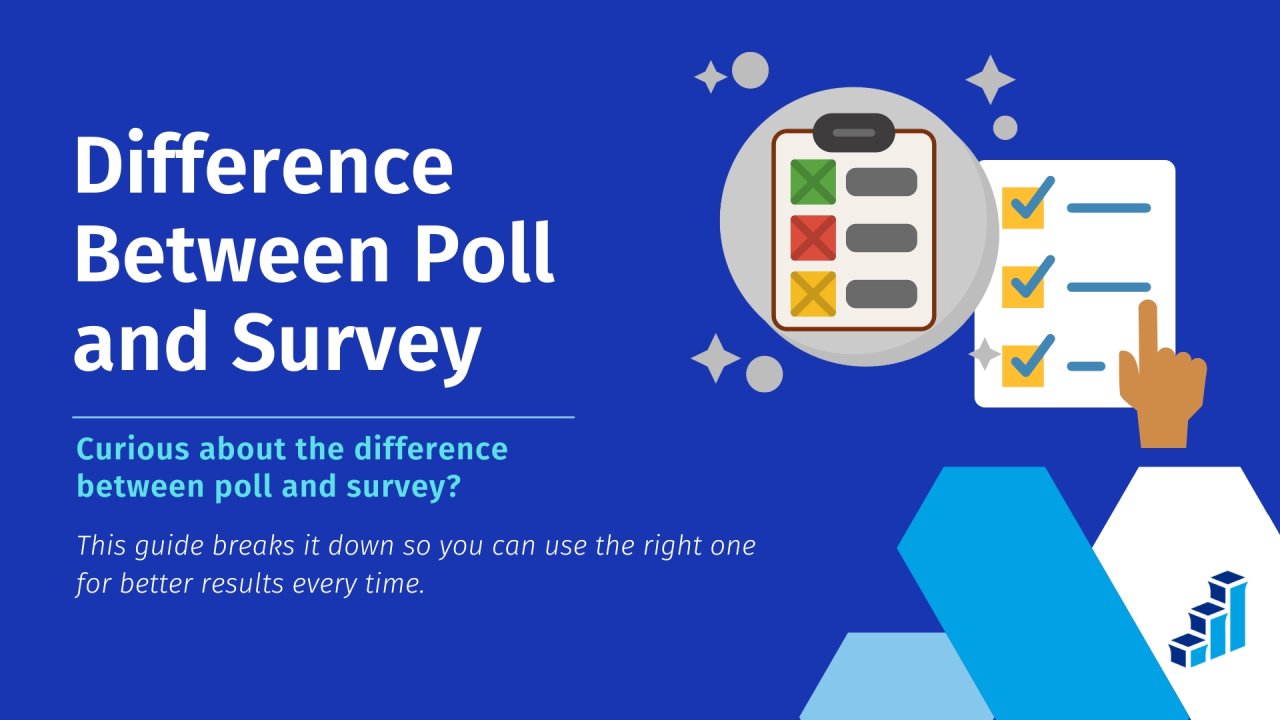
Difference Between Poll and Survey: Key Factors to Know
Data collection fuels decisions that shape businesses, politics, and society, whether it’s a company tweaking a product or a campaign gauging voter sentiment.
But here’s where things get murky: people often mix up polls and surveys, tossing around terms like poll vs survey without clarity. While both gather opinions, they’re not the same thing.
This article unpacks the difference between poll and survey, diving into their definitions, purposes, and quirks to help you understand what sets them apart and when to use each for reliable insights.
What Is a Poll?
To understand the difference between poll and survey, let’s start with what makes a poll unique.
Definition and Purpose
A poll is a quick snapshot of public opinion, often boiled down to a single question like “Who would you vote for today?”.
Designed for speed, what are polls if not tools to capture a moment’s mood?
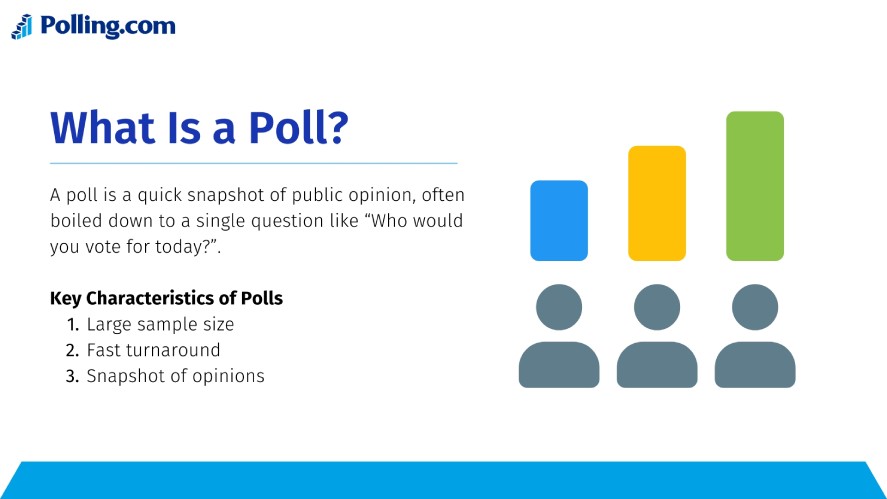
They shine in contexts like political races, media buzz, or marketing gut-checks, where define opinion polls as a way to gauge what a group thinks right now.
Polling data is typically collected fast to inform timely decisions, making polls a go-to for campaigns or news outlets needing instant takes from respondents.
Key Characteristics of Polls
Polls have a few standout traits that define how they’re conducted.
First, they often rely on a large sample size to ensure is polling accurate enough to reflect a population, like voters or consumers.
Second, they prioritize fast turnaround. How are polls conducted involves rapid data collection, often via phone or online, with results sometimes reported in hours.
Finally, polls deliver a snapshot of opinions, not deep dives. So they’re perfect for quick questions like “Do you approve of this policy?” but less suited for nuanced insights, setting a clear line in the difference between poll and survey.
What Is a Survey?
Now, let’s explore how surveys differ, offering a deeper dive into respondent insights.
Definition and Purpose
A survey goes deeper, designed to unearth detailed insights through multiple questions that probe attitudes, behaviors, or needs.
Unlike the quick hit of a poll, survey type matters in fields like market research, where a product feedback survey might explore why customers love or ditch a product, or in employee feedback and academic studies seeking richer data.
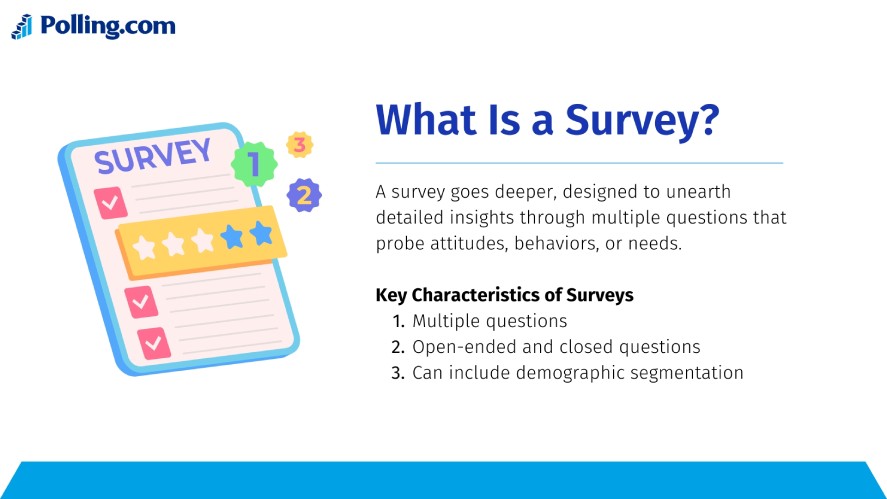
Surveys aim to paint a fuller picture, making them a staple for businesses or researchers who need more than a fleeting vibe to drive decisions.
Key Characteristics of Surveys
Surveys stand out with their depth and flexibility, a key point in survey versus questionnaire.
They typically include multiple questions, often a mix of closed and open-ended questions, to capture varied perspectives from respondents.
Many also use demographic segmentation, like age or income, to slice data for sharper insights, a hallmark of types of survey questionnaire in quantitative research.
This complexity makes surveys slower to run than polls but ideal for detailed analysis, cementing their role as the go-to for comprehensive feedback.
The Core Difference Between Poll and Survey
Digging into the difference between poll and survey reveals distinct approaches to gathering insights. Here’s how they stack up in depth, purpose, and effort.
Depth of Information
When it comes to polls and surveys, think breadth versus depth.
Polls aim for breadth, casting a wide net with a single question to capture what a large group thinks, like “Do you support this candidate?”. They’re built for quick, surface-level takes, prioritizing speed over nuance.
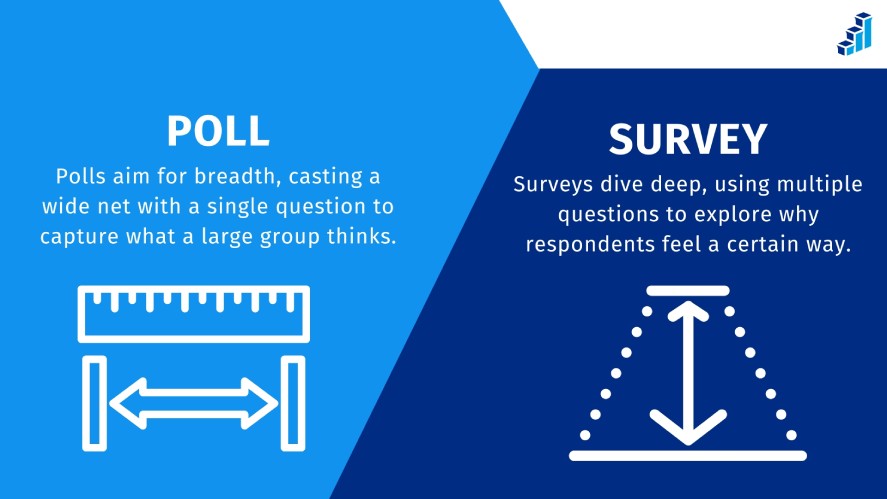
Surveys, on the other hand, dive deep, using multiple questions to explore why respondents feel a certain way, such as a survey type like a customer feedback form asking about product features, usability, and suggestions.
This depth makes surveys ideal for uncovering detailed patterns, while polls stick to broad strokes in the poll vs survey debate.
Use Cases
Choosing between a poll and a survey depends on your goal.
Use a poll when you need a fast pulse on public opinion, like gauging voter preference during an election season. They’re perfect for media, political campaigns, or quick marketing checks.
Surveys shine when you need rich insights, such as a market research to refine a product or employee feedback to boost morale.
For instance, a difference between survey and questionnare comes up here: surveys often include varied question types for depth, unlike simpler polls, making them better for complex decisions.
Methodology and Time Investment
The difference between poll and survey also shows in how they’re built and run.
Polls often involve a single question, random sampling, and quick methods like online or phone outreach, with analysis as simple as tallying percentages.
They’re low-time-investment, often wrapped up in days.
Surveys, like types of survey questionnaire in quantitative research, require more: designing multiple questions, targeting specific demographics, and collecting data over weeks.
Analysis is heavier too, involving stats like averages or sentiment coding, making surveys a bigger lift but richer in payoff for detailed insights.
Poll vs. Survey: Which Is More Accurate?
When it comes to how accurate polls and surveys are, the answer depends largely on their methodology, sample size, and design.
Polls are typically brief and time-sensitive, aimed at gauging immediate public opinion. They’re often used in opinion polling, such as during elections or market launches.
But their speed comes with trade-offs: polling techniques like robocalls or online pop-ups may not capture a truly representative sample, leading to sampling bias.
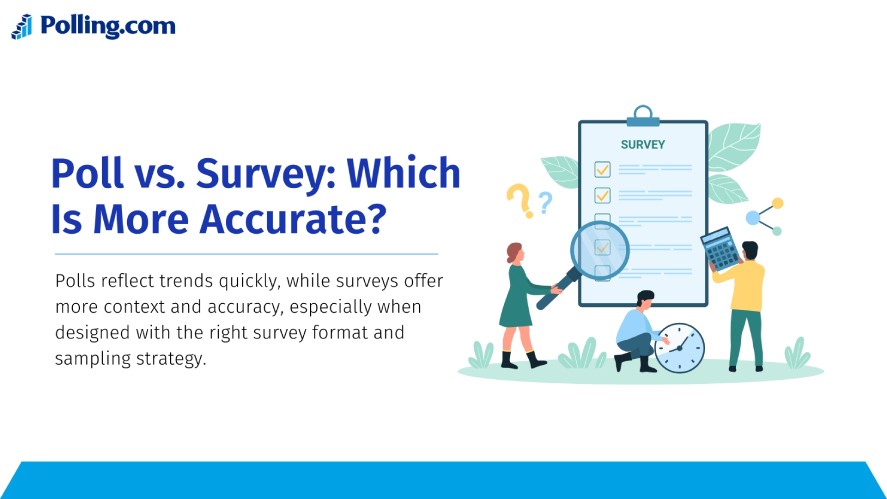
Surveys, on the other hand, are often longer, more detailed, and use structured data collection methods like quantitative questionnaires or structured surveys.
When executed properly, using proper survey methodology, they tend to provide deeper and more reliable insights.
In short, polls reflect trends quickly, while surveys offer more context and accuracy, especially when designed with the right survey format and sampling strategy.
Can a Survey Include a Poll?
A survey can include a poll, especially as a quick way to engage respondents early on.
For instance, in a customer feedback survey, the first question might be something like: “Would you recommend us to a friend?”. This acts as a poll-style question, offering a snapshot of sentiment.
After that, the survey can continue with more detailed questions that explore satisfaction, preferences, and needs, using a mix of feedback gathering tools and types of survey questionnaire in quantitative research.
This hybrid format allows organizations to gather both polling data and in-depth feedback in a single run. It also illustrates how questionnaire vs. poll doesn’t have to be a strict either-or; you can use both to your advantage.
Real-World Examples
Nothing clarifies the difference between poll and survey like seeing them in action. Here are two examples showing how each plays out.
Example of a Poll
Imagine a news outlet running a quick opinion poll on presidential approval:
“Do you approve of the president’s performance? Yes/No”.
Sent to 2,000 respondents via an online panel, it’s done in 24 hours, with results showing 45% approval ±3%.
This definition of polling, which is fast, focused, and broad, fits perfectly for media reporting or campaign tracking, where how accurate are polls before elections matter.
It’s a classic poll, delivering polling data that’s timely but light on why people feel that way.
Example of a Survey
Contrast that with a retailer’s customer satisfaction survey, like a Net Promoter Score (NPS) setup.
Over two weeks, 1,000 customers get a survey type with 10 questions: “How likely are you to recommend us? (0-10)”, “What’s one thing we could improve?”, and demographic prompts like age.
Results show an NPS of 60, with 25% citing slow shipping as a pain point.
This depth lets the retailer tweak logistics, a hallmark of surveys in market research that goes beyond the quick hit of polls and surveys.
Choosing the Right Tool for Your Needs
Knowing the difference between poll and survey helps you pick the right method for your goals, and the right platform makes it even easier.
Quick Decision-Making: Go With a Poll
When time’s tight and you need a fast read on what people think, a poll is your best bet.
Whether it’s a media outlet checking voter sentiment or a brand testing ad appeal, polls deliver quick polling data with minimal fuss.
For example, asking “Which logo do you prefer?” to 1,000 respondents can yield results in a day, guiding a snap decision.
Their speed and simplicity make polls ideal for urgent calls in politics or marketing.
In-Depth Insights: Use a Survey
For deeper questions, like improving a product or understanding employee morale, a survey is your tool.
A survey type like an employee engagement questionnaire, with questions like “What motivates you at work?” and “Rate our benefits (1-5)”, uncovers patterns over weeks.
This depth fuels big decisions, like revamping a service based on customer complaints.
In the end, surveys take longer but pay off with insights that polls can’t touch in the poll vs survey equation.
Why Polling.com Offers the Best of Both
Polling.com stands out by blending the speed of polls with the depth of surveys, making it a top pick for tackling the difference between poll and survey.
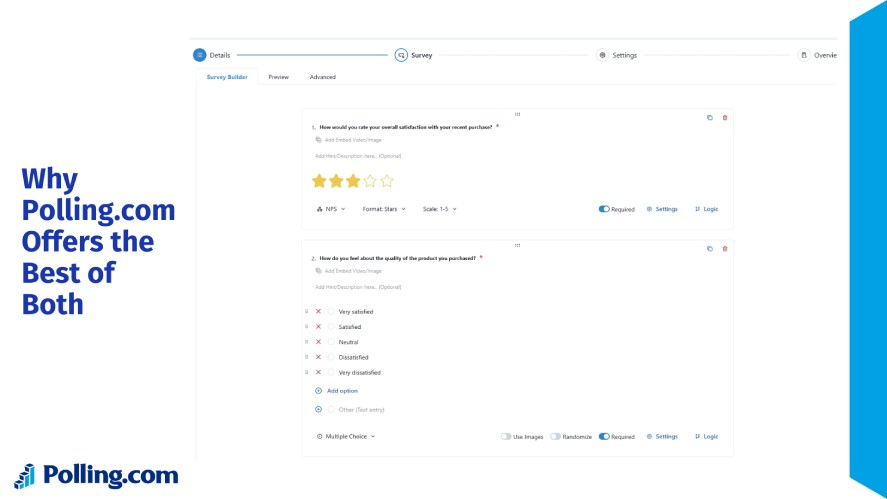
Its customizable templates let you craft a quick poll or detailed different survey types in minutes, with options for multiple-choice, open-ended, or demographic questions.
Fast results, often within hours for polls, keep you agile, while advanced analytics dive into survey responses for trends. Plus, Polling.com’s free options make it accessible for all.
Whether you’re running a one-question voter poll or a 10-question customer feedback survey, Polling.com’s flexibility, unlike rigid platforms, supports both.
Conclusion
The difference between poll and survey boils down to speed versus depth. So, choosing the right method shapes how well your data drives decisions.
With poll vs survey clarified, you can pick the tool that fits, and there’s no better place to start than Polling.com, where free, flexible tools let you run both polls and surveys with ease.
Try Polling.com today to see how simple it is to gather the insights you need!
